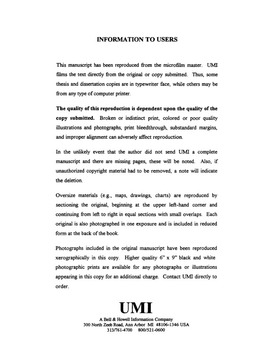| dc.contributor.advisor | Lee, Lloyd L., | en_US |
| dc.contributor.author | Harmon, Steven Charles. | en_US |
| dc.date.accessioned | 2013-08-16T12:30:20Z | |
| dc.date.available | 2013-08-16T12:30:20Z | |
| dc.date.issued | 1998 | en_US |
| dc.identifier.uri | https://hdl.handle.net/11244/5722 | |
| dc.description.abstract | This work uses a preexisting, noncubic EOS to predict polar/nonpolar pure components. This EOS uses the mixing rules of a preexisting local composition model (LCM) that can simultaneously (1) simulate both liquid and vapor compositions and (2) employ one (or more) pure-component equation(s) of state. The practical application entailed composition predictions of natural-gas dehydrators, including pure-component vapor-pressure and liquid-density simulations for ethylene glycol, diethylene glycol, triethylene glycol, five aromatic compounds, and two freons. | en_US |
| dc.description.abstract | This work introduces the generalized asymmetric rule (GAR) for equation-of-state (EOS) models. The GAR constitutes a novel equation that models unlike-interaction parameters (UIPs) in the simulation of vapor-liquid equilibrium (VLE) mixture compositions. | en_US |
| dc.description.abstract | A third appendix details limiting cases of both the GSR and GAR; a fourth appendix lists literature sources of mixture data, including VLE and other thermodynamic properties. Finally, the dissertation also lists pure-component property sources including vapor pressure, liquid density, enthalpy, and other thermodynamic properties. | en_US |
| dc.description.abstract | The GAR was developed by the author of this work and can replace binary interaction parameters (BIPs), a long-recognized UIP modeling standard. Overall, GARs present three basic advantages: First, GARs can provide up to a three-dimensional representation, or "mapping, " of binary systems in lieu of one-dimensional BIP representations. Second, GARs indicate how much one component "outweighs" another for a given UIP. Third, GARs offer a nondivergent mechanism that guarantees a reliable asymmetry model for UlPs. | en_US |
| dc.description.abstract | The GAR can average numbers of positive, negative, and/or zero numerical values. Moreover, the GAR can invoke positive/negative sign changes for numbers of like and/or unlike signs. The GAR therefore holds potential for other fields whenever any given set of numbers must be averaged asymmetrically. | en_US |
| dc.description.abstract | Overall, GARs surpassed BIN in over half of all results. Furthermore, this work briefly reviews literature methods that can overcome limitations of insufficient ternary binary VLE data. These methods include the use of (1) solubility data, (2) ternary data, (3) other thermodynamic property data, (4) infinite-dilution activity coefficients, (5) the substitution of alternate isomeric-component data, and (6) interpolation with the GAR. Two appendices suggest future methods of binary/multicomponent VLE modeling and overcoming parameter-correlation problems. | en_US |
| dc.format.extent | xxii, 313 leaves ; | en_US |
| dc.subject | Equations of state. | en_US |
| dc.subject | Vapor-liquid equilibrium. | en_US |
| dc.subject | Engineering, Chemical. | en_US |
| dc.subject | Mathematics. | en_US |
| dc.subject | Chemistry, Physical. | en_US |
| dc.subject | Asymmetry (Chemistry) | en_US |
| dc.title | The generalized asymmetric rule (GAR): The optimization of mixture asymmetry in a noncubic equation of state. | en_US |
| dc.type | Thesis | en_US |
| dc.thesis.degree | Ph.D. | en_US |
| dc.thesis.degreeDiscipline | School of Chemical, Biological and Materials Engineering | en_US |
| dc.note | Major Professor: Lloyd L. Lee. | en_US |
| dc.note | Source: Dissertation Abstracts International, Volume: 59-11, Section: B, page: 5961. | en_US |
| ou.identifier | (UMI)AAI9911855 | en_US |
| ou.group | College of Engineering::School of Chemical, Biological and Materials Engineering | |
